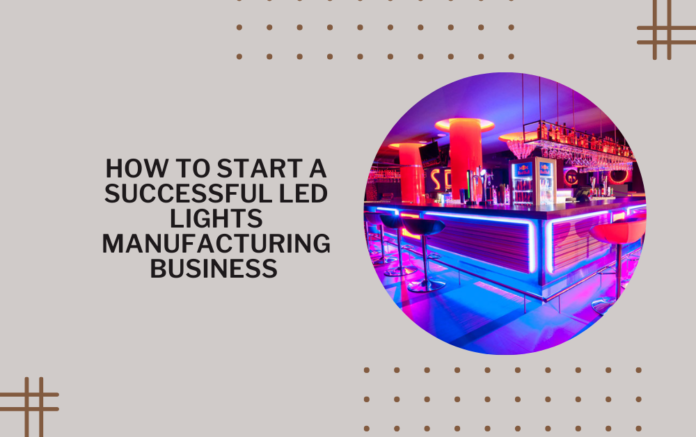Introduction
The LED lighting industry is booming, driven by increasing demand for energy-efficient, long-lasting, and environmentally friendly lighting solutions. Starting an LED manufacturing business can be a profitable venture, but it requires careful planning, significant investment, and a clear understanding of the market. This article will guide you through the steps to start your own LED club lights manufacturing business, from initial planning and securing funding to setting up production and marketing your products. By following these steps, you can tap into this growing market and build a successful business.
Research and Market Analysis
Before diving into the LED manufacturing business, it is crucial to conduct thorough research and market analysis. Understanding the current market trends, competition, and customer needs will help you make informed decisions and identify opportunities.
Start by analyzing the demand for LED lights in different sectors, such as residential, commercial, industrial, and automotive. Identify the key players in the market and study their product offerings, pricing strategies, and market positioning. This will help you understand what works and what doesn’t, and identify gaps that your business can fill.
Additionally, research the technological advancements in LED lighting and stay updated on industry standards and regulations. This will ensure that your products meet the required quality and safety standards, giving you a competitive edge.
Business Plan Development
A well-crafted business plan is essential for the success of your LED manufacturing business. It serves as a roadmap, outlining your business goals, strategies, and financial projections. Here are the key components of a business plan:
- Executive Summary: Provide a brief overview of your business, including your mission statement, business objectives, and the products you plan to manufacture.
- Market Analysis: Summarize your market research findings, including target market, customer segments, market trends, and competitive analysis.
- Product Line: Describe the types of LED lights you plan to manufacture, highlighting their features, benefits, and unique selling points.
- Marketing Strategy: Outline your marketing and sales strategies, including pricing, distribution channels, promotional activities, and customer acquisition plans.
- Operations Plan: Detail the production process, including the required machinery, raw materials, and workforce. Include information on suppliers, production timelines, and quality control measures.
- Financial Projections: Provide a detailed financial plan, including startup costs, revenue projections, profit margins, and break-even analysis.
- Funding Requirements: Specify the amount of funding you need to start and grow your business, and outline your funding strategy, whether it’s through loans, investors, or personal savings.
Securing Funding
Starting an LED manufacturing business requires significant capital investment for machinery, raw materials, labor, and other operational costs. Securing adequate funding is crucial for the success of your venture.
Explore various funding options, such as:
- Bank Loans: Approach banks and financial institutions for business loans. Prepare a solid business plan and financial projections to convince lenders of your business’s viability.
- Investors: Seek investment from venture capitalists or angel investors who are interested in the LED lighting industry. Present your business plan and demonstrate the potential for high returns.
- Government Grants: Research government grants and subsidies available for businesses in the renewable energy or energy-efficient technology sectors.
- Personal Savings: Use your personal savings or funds from family and friends to finance your business. This can be a viable option if you have sufficient resources and want to retain full ownership of your business.
Setting Up Manufacturing Facilities
Once you have secured funding, the next step is to set up your manufacturing facilities. This involves selecting a suitable location, purchasing machinery and equipment, and setting up production lines.
Location
Choose a location that is easily accessible for transportation of raw materials and finished products. Consider factors such as proximity to suppliers, availability of skilled labor, and local regulations. Ensure that the location has adequate space for production, storage, and office operations.
Machinery and Equipment
Invest in high-quality machinery and equipment required for LED manufacturing. This includes machines for LED chip assembly, soldering, testing, and packaging. Research the latest technology and choose equipment that offers efficiency, precision, and scalability.
Raw Materials
Establish relationships with reliable suppliers for raw materials, such as LED chips, drivers, heat sinks, and other components. Ensure that the materials meet industry standards and are available at competitive prices.

Workforce
Hire skilled and experienced workers for your manufacturing unit. This includes engineers, technicians, quality control personnel, and production staff. Provide training to ensure they are familiar with the production processes and quality standards.
Quality Control
Implement strict quality control measures to ensure that your products meet the required standards. This includes testing the LED chips, checking the assembly process, and conducting final inspections before packaging and shipping. Quality control is crucial for building a reputable brand and ensuring customer satisfaction.
Product Development and Testing
Develop a range of LED products that cater to different customer needs and preferences. This includes LED bulbs, tubes, panels, street lights, and specialty lighting solutions.
Design and Prototyping
Work with engineers and designers to create product designs that are functional, efficient, and aesthetically pleasing. Develop prototypes and conduct rigorous testing to ensure that they meet performance and safety standards.
Certification
Obtain the necessary certifications for your products, such as CE, RoHS, and UL. These certifications demonstrate that your products meet international quality and safety standards, enhancing their marketability.
Marketing and Sales Strategy
A robust marketing and sales strategy is essential for promoting your LED products and attracting customers. Here are some effective strategies:
Branding
Develop a strong brand identity that reflects your business values and product quality. This includes creating a memorable brand name, logo, and tagline. Invest in professional branding services to ensure consistency across all marketing materials.
Online Presence
Create a professional website that showcases your products, highlights their features, and provides information about your business. Optimize your website for search engines (SEO) to attract organic traffic. Utilize social media platforms to engage with potential customers and build a loyal following.
Distribution Channels
Establish distribution channels to reach your target customers. This includes partnering with wholesalers, retailers, and online marketplaces. Consider setting up your own online store to sell directly to customers.
Promotions
Implement promotional strategies to attract customers and generate sales. This includes offering discounts, running advertising campaigns, and participating in trade shows and industry events.
Customer Service
Provide excellent customer service to build trust and loyalty. This includes offering warranties, providing technical support, and addressing customer inquiries promptly.
| Step | Description |
|---|---|
| Research and Market Analysis | Conduct thorough research on market trends, competition, and customer needs. |
| Business Plan Development | Create a comprehensive business plan outlining goals, strategies, and financial projections. |
| Securing Funding | Explore funding options such as bank loans, investors, and government grants. |
| Setting Up Manufacturing Facilities | Choose a location, purchase machinery, and hire skilled workers. |
| Product Development and Testing | Design, prototype, and test products to ensure quality and performance. |
| Marketing and Sales Strategy | Develop branding, establish distribution channels, and implement promotional strategies. |
Conclusion
Starting an LED manufacturing business can be a lucrative venture, given the growing demand for energy-efficient lighting solutions. By conducting thorough research, developing a solid business plan, securing adequate funding, and setting up efficient manufacturing facilities, you can build a successful business in this booming industry.
Focus on quality and innovation to differentiate your products from the competition. Implement effective marketing and sales strategies to reach your target customers and build a strong brand presence. With dedication and strategic planning, you can illuminate the path to success in the LED lighting industry.
Embark on this journey with confidence, knowing that you have the knowledge and resources to create a thriving LED manufacturing business. The future of lighting is bright, and with the right approach, your business can shine brightly in this competitive market.
Note :- To Read More Articles Visit on- getmeta

